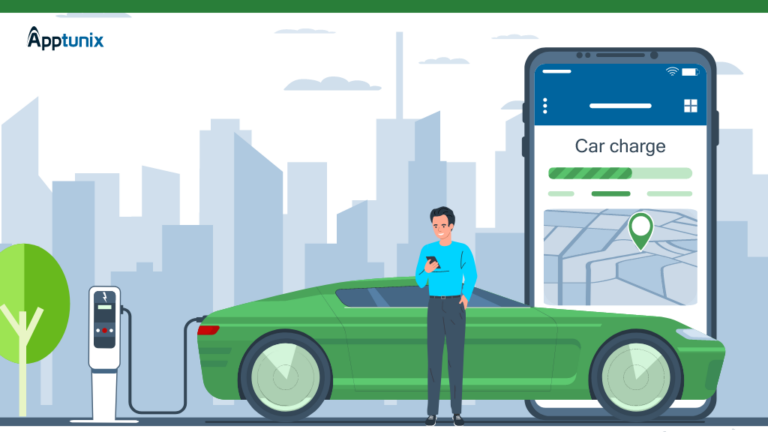These days, “AI-Powered Taxi App Development” is the buzzword.
Why?
Few years back, safe and personalized rides with contactless payments at pocket-friendly prices seemed like a distant dream. Fast-forward to today, these features are the bare minimum of a taxi booking app development. The driving force behind this exceptional transition is Artificial Intelligence and Machine Learning.
If you are wondering about how much taxi app development generates revenue for a business, you must check out these stats. The taxi app market is estimated to reach a substantial of $283 billion by 2028.

The global number of users in the ride hailing industry is continuously increasing between 2024 to 2028 by 217.6 million users in total.

Amazing, right?
These whopping numbers underline that the “Taxi-ride hailing segment” are emerging hotbeds in the Middle East and North American countries. A handful of successful names in the ride-hailing and taxi booking apps are Uber, Lyft, Careem, etc.
But where is the twist? AI powered taxi app development is the greatest twist that can make any ordinary mobile app into a million-dollar app unlocking the behemoth potential of your taxi business.
Curious about how these emerging technologies are cementing their footsteps in the convenience and efficiency world? Let’s explore.
How AI is Reshaping Taxi App Development?
There’s no doubt that artificial intelligence is transmogrifying the future of ride-hailing in unimaginable ways, benefiting both users and drivers. Here are some crucial areas where AI is making big impacts.

-
Improved Efficiency and Convenience
- Rising Pricing Management – AI powered taxi apps can easily predict periods of high demand and adjust rates accordingly, ensuring fair prices for commuters and eliminating unexpected raises that deter users.
- Personalized Experience – Artificial intelligence learns user preferences like preferred vehicle types, music genres, temperature preferences, personalizing the ride experience for utmost comfort.
-
Real-Time Data Analysis
- An experienced taxi booking app development company ensures the integration of AI/ML assisting in time analysis, travel, traffic management, and weather conditions during commuting.
- With real-time data analysis, users can identify the demand and supply of the ride, letting you know the availability of the ride status.
-
Customization
- Users are offered personalized experiences with AI-powered taxi app development.
- Customization is important to impress users, thus by offering satisfying services, eventually the number of bookings increases.
- The taxi booking app analyzes customer travel preferences and history, providing personalized routes, deals and offers.
- By partnering with an experienced taxi app development company, you can offer a competitive edge to users by suggesting nearby restaurants and popular eateries.
-
Fraud Detection
- By utilizing the potential of AI and ML algorithms, taxi booking apps efficiently eliminate any slim chances of fraud.
- AI-driven taxi apps can analyze user behaviour and identify unusual patterns that don’t match with the normal ways of using apps.
- Booking multiple rides at the same time indicates the chances of fraudulent activity and initiates an appropriate action.
-
Predictive Maintenance
- AI/ML algorithms also identify the core problems and analyze the vehicle performance.
- It minimizes maintenance costs, ensuring the vehicle is in good condition for a longer time.
- Predictive analysis helps drivers stay informed while eliminating any possibility of breakdown.
-
Driver Management
- Artificial Intelligence can manage driver’s efficiency and overall conduct.
- The AI/ML algorithms analyze driver behaviour, speed and acceleration, and brake patterns to share feedback and help them improve their performance.
-
Dynamic Pricing Methodology
- Pocket-friendly rides with online taxi booking apps are possible because of AI/ML.
- In the AI-driven dynamic pricing system, several factors are considered like time of day, special events, demand, and traffic conditions that define fair compensation for riders for their services.

-
Intelligent Route Optimization
- Route optimization saves on fuel costs exceptionally. Plus, it also saves ample time for riders.
- Like Uber uses AI algorithms for identifying data points, other taxi apps can also leverage it to analyze historical traffic patterns, real-time road conditions, etc suggesting optimal navigation.
-
Enhanced Customer Experience with AI-Bots
- Skip the queue of customer query assistance with AI-powered bots. The modern taxi booking app provides instant answers to all customer queries in a seamless manner.
- These AI bots extract information from every kind of interaction and eventually become smarter and more efficient.
10. Integrated Payment Systems
- For a flawless user experience, online payment integration is unskippable.
- AI-powered taxi booking apps blend numerous payment methods like debit/credit cards, wallet payment, UPI transaction etc for a secure and flawless payment experience.
11. Accurate ETAs (Estimated Time of Arrival)
- Traditional taxi booking services are irksome because of unpredictable weather conditions, traffic updates, no real-time data availability and no GPS integration.
- This is beneficial for users as they’ll know the accurate time of ride arrival, enhancing the customer satisfaction quotient.
12. Smart Assistance
- AI-powered taxi booking apps offer individualized assistance by using several features like voice-activated bookings, real-time journey tracking and automatic price calculating.
- AI-bots help you navigate easily with real-time traffic updates while responding to customer inquiries.
- With voice-activated booking features integrated with AI, you ensure a smooth and convenient journey merely with one click.
13. Future-Proof Industry
- Sustainability – AI route optimization helps in reducing emissions and fuel consumption, contributing towards a more sustainable transportation ecosystem.
- Autonomous Vehicles – Artificial intelligence plays an important role in developing and integrating technology in autonomous vehicles. These vehicles are synonymous to self-driving cars and have the potential to revolutionize the future of transportation.
- Multimodal Integration – AI establishes ride-hailing services with other transportation services like e-scooters and bicycles, providing hassle-free multimodal journeys for users.
14. Integration with Smart City Initiative
- AI-powered taxi booking apps can be integrated with smart city initiatives. By capitalizing on artificial intelligence’s potential to integrate with smart infrastructure and use data analytics, these apps assist urban planners to optimize transportation networks, minimize energy consumption and improve traffic flow.
How To Build a Taxi Booking App?
Building a taxi booking app that resonates with your user needs and simultaneously stands the test of time requires a strategic approach. Here’s an optimal, five-step approach for creating a taxi booking app.

Step 1: Market Analysis and Conceptualization
- Understand User Needs and Market Gaps – Start with an in-depth analysis of the market to understand the user needs and identify and address gaps in the existing market. This process includes analyzing competitor offerings, current market trends and user reviews. To do this, use surveys, focus groups and competitor analysis tools to collect insights.
- Defining Unique Value Proposition (UVP) – After research and analysis, articulate a UVP addressing unmet needs for better solutions compared to what’s presently available. This often varies from offering minimal price points to providing luxury services or focusing on niche markets like environmentally friendly rides or carpooling.
Step 2: Designing and UX
- Engaging Prototyping – Create prototypes that stimulate the real app experience. Tools like Adobe XD or Figma help in creating interactive prototypes that are invaluable for user testing. Collect feedback from potential users and iterate on the design before going into the development phase.
- Crafting a User-Oriented Design – Designing is not just about aesthetics, indeed it’s more about creating an intuitive user experience. Thus, focus on streamlining the journey from opening the app to booking a ride. It includes creating a logical flow, minimizing the taps to book a ride and adhering to policies for specially-abled commuters.
Step 3: Development and Quality Assurance
- Agile Development Approach – Opting for an agile approach ensures transparency in the project completion. Here, the project is divided into sprints that focus on delivering specific features, promoting flexibility, faster time to market and regular improvement based on feedback.
- Picking the Right Tech Stack – Choosing the right technology stack ensures scalability, security as well as cross-platform compatibility. For example, leveraging Flutter enables cross-platform development, whereas Node.js serves as a dynamic backend solution.
- Test, Test and Test – Plan comprehensive testing, consisting of user acceptance tests (UAT) and unit testing, to ensure the app is trusted, secure and user-friendly. Also, remember to test the app under different network conditions and on multiple devices.
Step 4: Roll-Out Strategy and User Acquisition
- Marketing and Promotion -Create an elaborative marketing strategy that consists of everything from social media marketing, and targeted ads to user-generated content marketing. Plus, consider launching a referral program to motivate existing users to invite their friends.
- App Store Optimization – This is the new buzzword nowadays, especially when it’s about app success. Before launching the app, optimize the app’s listing on the respective stores with compelling keywords, screenshots, and short and long-form descriptions for improved visibility and increased organic traffic.
- Collecting User Feedback – After rolling out the app, monitor user feedback and app performance metrics. This initial feedback is beneficial for identifying any potential red flags or addressing the user’s needs.
Step 5: Feedback, Iterations and Growth
- Constant Improvement – Ask your taxi booking app development company to use user feedback and performance data for continuous improvements. Prioritize updates based on user demand and the strategic importance of features and functionalities.
- App Scalability – Accompanied with a growing user base, there’s need to scale the app’s infrastructure to maintain performance. This involves optimizing your database, growing your server capacity or establishing more efficient code.
- Emerging to New Horizons – Do consider geographical expansions or adding new services to your array as it grows. Plus, make sure to do homework by acknowledging the local needs and preferences.
Adhering to these 5 easy steps and focusing on constant improvement and user feedback, you create a taxi booking app that not only addresses the user’s pain points but is poised for future growth and success.
Finally, How Much Does It Cost to Create a Taxi Booking App?
The cost for taxi booking app development varies significantly based on the complexity level, chosen technology stack and the geographical location of the taxi app development company. Primarily, ride-hailing apps are categorized into three sections – simple, complex and advanced.
Here’s a breakdown of the cost implications for each segment, in reference to budget, timeline and must-have features.
Simple Taxi Booking App
- Budget Bracket – The cost of building a simple taxi app varies from <$10,000 to $15,000. This variation largely depends on the location of the development team like the USA or a lower-cost region like Asia.
- Timeline – A simple taxi booking app can take 2 to 4 months to develop, considering the feature set and one platform (iOS or Android).
- Basic Features – The basic features include user registration, profile management, basic booking and cancellation, driver and vehicle details, payment gateway integration, GPS integration, ratings and reviews.
These apps are recommended for startups or entrepreneurs who are looking to test the water with MVP.
Complex Taxi Booking App
- Budget Bracket – Creating a complex app with a handful of sophisticated features, the prices accommodate between <$15,000 to $20,000. Also, they are deployed for both Android and iOS platforms using a cross-platform development framework like Flutter.
- Timeline – The estimated timeline for a complex taxi booking app is 4 to 6 months. However, the extended time is for the integration of a more refined user interface and expertise.
- Basic Features – The basic features encapsulated in this segment are advanced booking options like scheduled rides, in-app messaging to drivers, loyalty program and dynamic pricing, enhanced payment options and fare estimation or dynamic pricing.
These types of apps make them an ideal fit for businesses ready to invest significantly to offer a competitive product in the market.
Advanced AI-Powered Taxi App Development
- Budget Bracket -The development cost for an advanced taxi booking app varies between the budget bracket of <$25,000 to $35,000 or more. These apps include comprehensive features, high-end personalization and scalability.
- Timeline – Such advanced apps take nearly 6-12 months, considering the complexity, testing and deployment phases involved.
- Basic Features – The feature set of these apps includes AI-driven analysis for route optimization and demand forecasting, multi-language support, advanced safety features (SOS button, multiple stoppages, non-movement of vehicle), integration with third-party apps (like music streaming apps) and real-time insights and notifications.
An AI-driven taxi app is aimed at established businesses or corporations looking to dominate the lion’s share in the market with enhanced user experience, operational efficiency and security.

Finally…
Startups and young entrepreneurs fascinated by the latest technologies must consider building an AI-powered taxi booking app. Nonetheless, AI has magnificently transformed the ride-hailing segment, improving the user experience with functionalities like heightened security, accurate ETA, predictive pricing and multiple payment options. These innovations have opened endless opportunities to tap into a profitable market that benefits riders, operators and drivers alike.
If you are of the mind to cement your footsteps in this burgeoning market, start by partnering with a reputable and experienced taxi booking app development company like Apptunix. Their expertise in AI promises to cater needs of drivers and passengers, ensuring the success of your ride-hailing app.
Remember, by embracing AI now, you get a first-mover advantage in urban mobility all while curating yourself as an industry disruptor.













